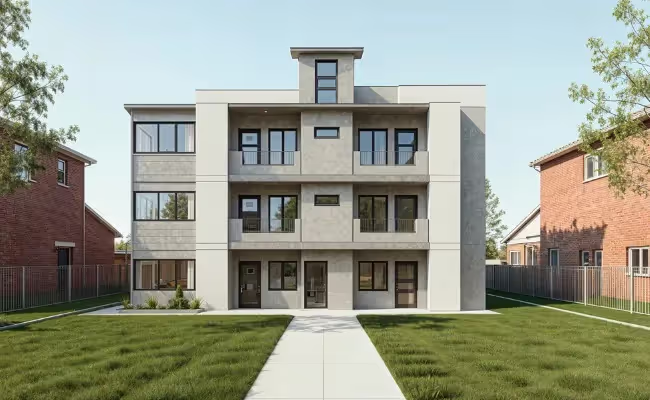.webp)
This urban infill ADU project in San Diego transformed a standard 140’ x 50’ lot into a high-density residential site through strategic planning and code-aligned design. The site originally featured a 1,175 sq. ft. single-family home with 2 bedrooms, 2 bathrooms, and an attached garage.
Rather than demolish the existing home, the project retained it and added density through a garage conversion and a new multi-unit configuration. In total, the project delivered 13 residential units by leveraging the California ADU Density Bonus Program.
Key features include:
This project exemplifies how to unlock maximum housing density on a small urban site—without displacing existing housing stock.
This project was driven by a clear mandate: to achieve the highest and best use of the property, in its truest form. That meant addressing all four key development criteria:
1. Physically possible
2. Legally permissible
3. Financially feasible
4. Maximally productive
With only 64 feet of buildable depth and a site width of 50 feet, the available footprint was highly constrained. Achieving maximum density under these spatial conditions required a deep understanding of zoning, building code, and financial modeling.
Infill projects at this scale often face limitations related to required stairwells, unit efficiency, and municipal density regulations—especially when pushing the limits of what is financially viable.
To navigate these constraints and avoid triggering affordable unit replacement requirements, the client pursued a design strategy focused on efficiency and code-smart planning. The solution? A 12-unit addition designed to fit within a 64' x 50' buildable area, guided by an in-depth analysis of allowable density under the ADU bonus framework.
To optimize rentable space, the design team leveraged California Building Code Section 1006.3.4(1), which permits a single stair in certain multi-unit residential projects. This code interpretation allowed the team to eliminate one full stair core—increasing rentable square footage and unlocking more usable area per floor.
This key design move dramatically improved internal layout flexibility and supported higher unit efficiency without compromising safety or code compliance.
The results of this infill ADU project are nothing short of extraordinary in terms of spatial efficiency and density performance:
By thinking beyond traditional multifamily layouts and leveraging both state and local ADU incentives, this development proves what's possible when architecture, code knowledge, and policy expertise come together to unlock a property’s full potential.

.webp)
.webp)